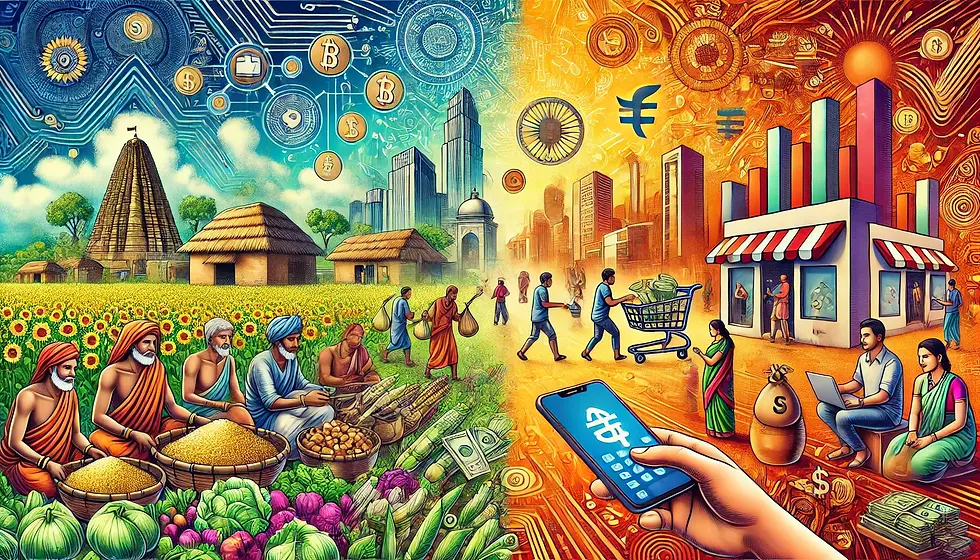Understanding the Distinctions Between Barter Economy and Money Economy
- bxiworldwebsite
- Jan 25
- 4 min read
The evolution of trade and commerce has significantly influenced human society and economic systems. Two primary forms of economic systems—the barter economy and the money economy—represent distinct methods of exchange that cater to different societal needs. Each system carries its unique characteristics, advantages, and limitations. In this blog, we will delve into the distinctions between a barter economy and a money economy, highlighting how each system functions and why money economies dominate modern trade. By incorporating essential keywords such as "barter economy," "money economy," "advantages of money over barter," and "differences between barter and money systems," we aim to provide a comprehensive understanding of these economic paradigms.
What Is a Barter Economy?

A barter economy is a system where goods and services are exchanged directly without using a standardized medium of exchange, such as money. It is one of the earliest forms of trade, dating back to prehistoric times. For instance, a farmer might trade surplus grain for a pot crafted by a local artisan. The barter economy operates on the principle of mutual exchange and requires both parties to agree on the value of the items or services being traded.
Key Characteristics of a Barter Economy
Direct Exchange: Goods and services are traded without any intermediary.
Double Coincidence of Wants: Both parties must want what the other offers.
Lack of Standardization: The value of goods and services is subjective and negotiable.
Localized Trade: Typically limited to smaller communities due to logistical challenges.
What Is a Money Economy?
A money economy, on the other hand, uses a standardized medium of exchange—money—to facilitate transactions. Money serves as a unit of account, a store of value, and a medium of exchange. Modern money economies encompass various forms of money, including coins, banknotes, and digital currencies, enabling seamless transactions in both local and global markets.
Key Characteristics of a Money Economy
Use of Money: Transactions involve a universally accepted medium of exchange.
Standardized Value: Prices are fixed based on a common monetary standard.
Efficient Transactions: Money eliminates the complexities of direct exchange.
Global Trade: A money economy facilitates large-scale and international trade.
Key Differences Between Barter Economy and Money Economy
Understanding the distinctions between these two economic systems requires a detailed comparison of their mechanisms and implications:
1. Medium of Exchange
Barter Economy: Relies on the direct exchange of goods and services. For example, a weaver might exchange fabric for food.
Money Economy: Money acts as an intermediary, simplifying trade. The weaver sells fabric for money and uses it to buy food.
2. Valuation
Barter Economy: Valuation is subjective and depends on negotiation between parties.
Money Economy: Valuation is objective and based on market prices.
3. Double Coincidence of Wants
Barter Economy: Requires mutual needs. If one party doesn’t want what the other offers, the trade cannot occur.
Money Economy: Eliminates this requirement. Money allows individuals to trade freely without matching specific wants.
4. Efficiency
Barter Economy: Time-consuming and inefficient due to the difficulty of finding suitable trade partners.
Money Economy: Facilitates quick and efficient transactions.
Read More Blog :- The Difference Between Barter Exchange and Money Exchange
5. Storage of Value
Barter Economy: Goods can be perishable or lose value over time, making it difficult to store wealth.
Money Economy: Money can be saved and invested, retaining its value over time (barring inflation).
6. Economic Complexity
Barter Economy: Suitable for simple economies with limited goods and services.
Money Economy: Enables the growth of complex economies and global trade networks.
Advantages of Money Over Barter Trade
The transition from a barter economy to a money economy was driven by the inefficiencies of barter trade. Let’s explore the key advantages of money:
Convenience: Money simplifies transactions by serving as a universally accepted medium of exchange.
Standardized Value: Provides a clear and consistent measure for pricing goods and services.
Storage of Wealth: Money allows individuals to save and accumulate wealth for future use.
Scalability: Supports large-scale and industrial economies, enabling economic growth.
Liquidity: Money is easily convertible into goods and services, offering unparalleled flexibility.
Global Trade: Facilitates international commerce by serving as a common exchange medium.
Limitations of Barter Economy
The barter economy, despite its historical significance, has notable limitations:
Inefficiency: Finding compatible trade partners is a time-intensive process.
Lack of Standard Value: Determining fair exchanges is challenging.
Perishability: Many goods cannot be stored for long periods.
Localized Scope: Limited to small communities and simple exchanges.
Modern Relevance of Barter Economy
While the money economy dominates modern trade, barter systems have not disappeared entirely. They find relevance in specific contexts, such as:
Economic Crises: When currency systems fail, communities often revert to barter trade.
Niche Markets: Online barter platforms and skill exchanges cater to individuals seeking alternative trade methods.
Cultural Preservation: Some traditional communities continue to use barter systems to maintain their heritage.
Transition from Barter Economy to Money Economy
The shift from barter to money economy was pivotal in the development of advanced civilizations. Early forms of money included commodities like gold, silver, and salt, which had intrinsic value. Over time, societies introduced standardized currencies, leading to the creation of modern financial systems. This transition not only improved efficiency but also laid the groundwork for global trade and economic integration.
Conclusion
The distinctions between a barter economy and a money economy highlight the evolution of trade and the growing complexities of human commerce. While the barter economy served as a foundation for early societies, its inefficiencies made way for the adoption of money as a superior medium of exchange. A money economy’s advantages, such as convenience, efficiency, and scalability, have made it indispensable in today’s interconnected world.
Understanding these economic systems allows us to appreciate the innovations that have shaped modern trade and consider how future developments, like digital currencies, will further transform commerce. Whether examining historical practices or modern applications, the interplay between barter and money economies offers valuable insights into the dynamics of human trade and economic growth.




Comments